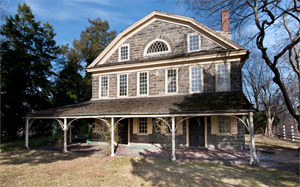
PHILADELPHIA — Cedar Grove, a historically important house located in Philadelphia’s West Fairmount Park, is closing for a major restoration project of the building’s exterior envelope and roof, which will continue into the fall of 2013. July 8, 2012 will be the last day Cedar Grove is open to the public until the project’s completion.
Cedar Grove was built as a country retreat by prominent Quaker Elizabeth Coates Paschall in 1750. Five subsequent generations of the Paschall and Morris families continued to add to the property as they made it their home. Originally constructed in the Frankford section of Philadelphia, the house was moved to its current location in 1926, after Lydia Thompson Morris generously donated Cedar Grove to the City of Philadelphia and the furnishings to the Philadelphia Museum of Art. The City, in an effort led by the Museum, moved the house to a location in West Fairmount Park overlooking the Schuylkill River and opened it to the public in 1928. By keeping Cedar Grove open for over 80 years as a historic home, the Museum has offered visitors a window onto the past complete with the furniture and household goods collected and used by members of the same family over the course of nearly two centuries. The restoration project is in keeping with the mission to keep this house in pristine condition and accessible to visitors for generations to come.
“The Philadelphia Museum of Art has a responsibility and desire to care for and maintain the remarkable properties it administers on behalf of the city,” said Timothy Rub, The George D. Widener Director and Chief Executive Officer. “Like the Rodin Museum, which has been restored and will open to the public once again on July 13, Cedar Grove must also close temporarily in order to be preserved for future Philadelphians to enjoy.”
While the unique interiors and historic furnishings of Cedar Grove have been well maintained, the restoration will give much-needed attention to the building’s exterior. Critical priorities for this project include storm water management, tree removal and pruning, re-shingling the roof, repointing all of the masonry, rebuilding the porch, and the repair of doors and windows. This two-story house is constructed in Wissahickon schist stone, which has weathered the property’s shaded the conditions well, but the exterior woodwork is in need of careful restoration.
This historic property tells the story of the daily life of five generations of a well-known Philadelphian family (descendants also left the Morris Arboretum to the University of Pennsylvania) through original household furnishings and records. Cedar Grove contains an extensive collection of furniture and the decorative arts, providing a rare opportunity for visitors to see these materials displayed in a historic context. The extensive documentation that the family kept includes the medicinal recipe book of the house founder, healer Elizabeth Coates Paschall, and the 1809 wedding dress and trousseau receipts of Lydia Poultney Thompson.
“Cedar Grove has within its walls the stories of 150 years of day-to-day living—the moments of happiness and those of struggle,” notes Justina Barrett, the Museum’s site manager for Cedar Grove. “When the site re-opens to the public, new programs will enable visitors to experience and appreciate Cedar Grove’s stories, collections, and spaces. Visitors can relate to a mother trying to find a medicine for her son’s colic, or a father watching his daughter toddle across the room. Because this house, as well as its furnishings and many of the documents have been preserved, we can really bring visitors into close conversation with the past.”
The scope of the project was defined through a comprehensive building assessment completed by Atkin Olshin Schade Architects and CVM Construction. In 2006 the Museum oversaw a similar preservation project with Mount Pleasant, a historic home also operated by the Philadelphia Museum of Art.
This project is generously supported by the William B. Dietrich Foundation and an anonymous donor. The William B. Dietrich Foundation also provided the primary funding for the earlier preservation project at Mount Pleasant.
# # #
ADDITIONAL IMAGE OF NOTE



